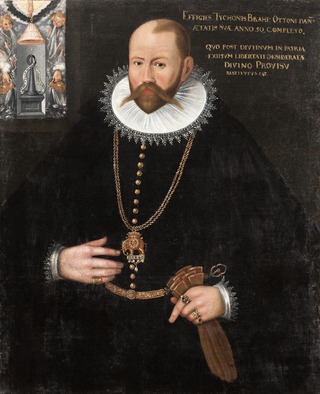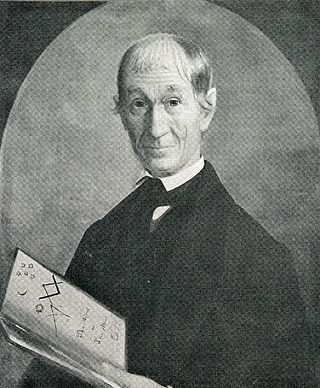
Tycho Brahe, generally called Tycho for short, was a Danish astronomer of the Renaissance, known for his comprehensive and unprecedentedly accurate astronomical observations. He was known during his lifetime as an astronomer, astrologer, and alchemist. He was the last major astronomer before the invention of the telescope. Tycho Brahe has also been described as the greatest pre-telescopic astronomer.

Benjamin Banneker was an American naturalist, mathematician, astronomer and almanac author. A landowner, he also worked as a surveyor and farmer.

An almanac is a regularly published listing of a set of current information about one or multiple subjects. It includes information like weather forecasts, farmers' planting dates, tide tables, and other tabular data often arranged according to the calendar. Celestial figures and various statistics are found in almanacs, such as the rising and setting times of the Sun and Moon, dates of eclipses, hours of high and low tides, and religious festivals. The set of events noted in an almanac may be tailored for a specific group of readers, such as farmers, sailors, or astronomers.
This article contains information about the literary events and publications of 1700.

Poor Richard's Almanack was a yearly almanac published by Benjamin Franklin, who adopted the pseudonym of "Poor Richard" or "Richard Saunders" for this purpose. The publication appeared continually from 1732 to 1758. It sold exceptionally well for a pamphlet published in the Thirteen Colonies; print runs reached 10,000 per year.

John Partridge was an English astrologer, the author and publisher of a number of astrological almanacs and books.

Aries is the first astrological sign in the zodiac, spanning the first 30 degrees of celestial longitude, and originates from the Aries constellation. Under the tropical zodiac, the Sun transits this sign from approximately March 21 to April 19 each year. This time-duration is exactly the first month of the Solar Hijri calendar.

The Old Farmer's Almanac is an almanac containing weather forecasts, planting charts, astronomical data, recipes, and articles. Topics include gardening, sports, astronomy, folklore, and predictions on trends in fashion, food, home, technology, and living for the coming year. Published every September, The Old Farmer's Almanac has been published continuously since 1792, making it the oldest continuously published periodical in North America. The publication follows in the heritage of American almanacs such as Benjamin Franklin’s Poor Richard's Almanack.

Old Moore's Almanac is an almanac which has been published for nearly two and a half centuries. Its founder, Theophilus Moore, ran a classical academy at Milltown which was then a village near Dublin. A teacher of Irish, English, Greek and Latin, he became known as a clever mathematician and a wizard of astrology, gaining the nickname 'The Irish Merlin'. He published his Old Moore's Almanac for the first time in 1764, and received such support that the other Irish almanacs gradually dwindled away. Theophilus Moore is now buried in the Drumcondra Churchyard, in Dublin, but the tradition of Old Moore's Almanac continues unbroken to this day.

Francis Moore was an English physician and astrologer who wrote and published what later became Old Moore's Almanack.
Titan Leeds (1699–1738) was an 18th-century American almanac publisher.

The early Christians, like the early Jews, were vehemently opposed to astrology, even attributing it to demonic origin.
Events from the year 1697 in England.

Dudley Leavitt was an American publisher. He was an early graduate of Phillips Exeter Academy in his native town of Exeter, New Hampshire, and later moved to Gilmanton where he first edited a newspaper and taught school. Within a few years, Leavitt relocated to Meredith, where in addition to teaching school and farming, he began publishing in 1797 Leavitt's Farmers Almanack, one of the nation's earliest farmers' almanacs. A polymath, Leavitt poured his knowledge of disparate fields including mathematics, language and astronomy into the wildly popular almanacs, which outlived their creator, being published until 1896. The inaugural issue of 1797 carried the title of The New England Calendar: Or, Almanack for the Year of Our Lord 1797. On the cover was the disclaimer that the new publication was "Calculated for the Meridian of Concord, Latitude 43° 14' N. Longitude 72° 45' W.: And with But Little Variation Will Answer for Any of the New England States."
Poor Robin was an English 17th and 18th-century satirical almanac series, appearing as Poor Robin's Almanack from 1663. Other similar writings by the pseudonymous Poor Robin were published later, in America and into the 19th century.

Vincent Wing (1619–1668) was an English astrologer and astronomer, professionally a land surveyor.

Edmund Weaver was an English astronomer, land surveyor, and friend to William Stukeley. Weaver's The British Telescope ephemerides is considered an important 18th-century publication on the movement of planets.

Urania Propitia is a book of astronomical tables written by Maria Cunitz and published in 1650. As Maria Cunitz was the daughter of both a physician and mathematician, it was her ability to grasp complex mathematics quickly and transcribe her findings as a polyglot that allowed her to do what few women had done before her.

George Parker (1654–1743) was an English astrologer and almanac maker, known as a controversialist.















